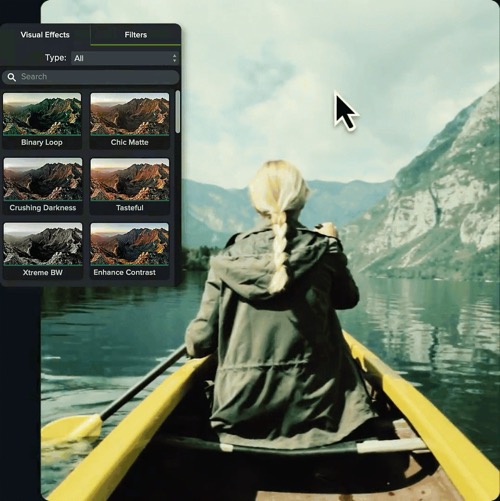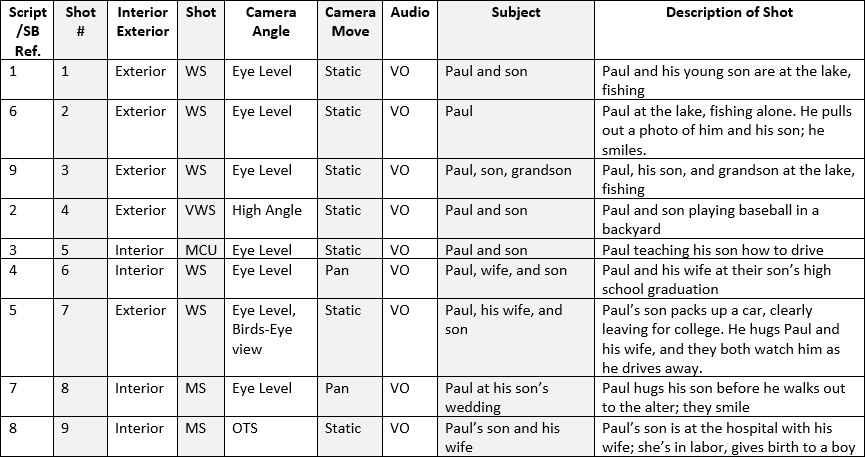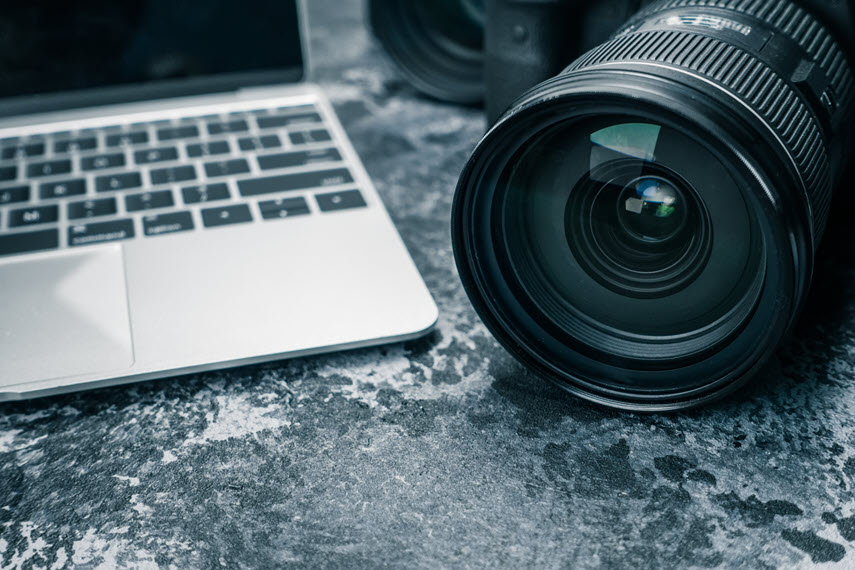When you start creating videos, there’s often a lot of preparation before you can even think about hitting the record button. If you will recording using a camera, you need to find a set, adjust lighting, and have the proper camera angles.
The best way to organize this preparation is with a shot list.
Even if your video will only use screen recordings without any camera footage, it’s helpful to have a shot list to help you identify and plan for everything you want to record.
What is a shot list?
A shot list is a document that maps out exactly what will occur and what will be used in that particular shot, or scene, of the video.
And, while your video probably isn’t a big Hollywood production, a shot list helps organize your thoughts and begin with a solid plan.
Shot lists go hand-in-hand as part of writing the script, creating a storyboard, and the overall pre-production process.
Make your own videos today!
Make professional-quality videos quickly and easily with Camtasia. Record your screen or upload an existing video, then bring the “Wow!” with effects, music, and much more.
Download for free now
Why are shot lists important?
If you’re asking yourself whether a shot list is really worth the effort, then allow us to answer that question for you: Yes it is!
A shot list is like a blueprint that acts as a roadmap for your entire project, offering a structured plan that everyone can follow. It ensures that all team members are aligned, setting the stage (quite literally!) for a successful shoot.
But why are they so important?
Firstly, shot lists save time. Having a predetermined list of shots helps you utilize your shooting hours more efficiently. It provides quick answers to questions like, “What are we shooting next?” or “Who will be on camera for this part?” Having this information in hand eliminates guesswork, speeding up the shoot and maintaining focus throughout production.
Secondly, a well-constructed shot list helps keep you prepared because it outlines what to expect at each step. This reduces the risk of misunderstandings and ensures the shoot runs as smoothly as possible.
In essence, a shot list helps streamline the creative and logistical aspects of making a video. It’s a guide to staying organized, saving time, and most importantly, capturing the footage that will bring your story to life.
The essential elements of a shot list
Now that we know why a shot list is so important, let’s take a look at how to make a shot list, starting with a breakdown of each of the key elements you should include:
- Script / SB reference: Indicates which part of the script or storyboard the shot corresponds to, ensuring alignment between planning and execution.
- Shot Number: The reference number assigned to each shot. This is essential for easy identification and organization.
- Interior / Exterior: Specifies whether the shot takes place indoors or outdoors. This is crucial for lighting and equipment planning.
- Shot: Identifies the type of shot — such as Wide Shot (WS), Medium Close-Up (MCU), or Very Wide Shot (VWS) — to establish the shot’s visual style.
- Camera Angle: Specifies the perspective from which the camera will capture the shot — like eye level, high angle, or even birds-eye view — adding layers of meaning to the scene.
- Camera Move: States whether the camera will remain static or employ a specific movement like panning, which affects the energy and pacing of the scene.
- Audio: Indicates if the shot includes specific audio elements like a voice-over (VO), an important note for post-production.
- Subject: Listing any people needed in the shot is an important detail for scheduling and ensures all team members know what should be captured.
- Description of Shot: This is a detailed summary of the shot in question, including the visual elements and type of shot to help guide the director, cinematographer, and crew.
While there is fundamental information that should be included on every shot list, there’s no right or wrong way for you to put yours together. This is a tool for your production and the most important thing for you is to make sure you have all the information you and your crew will need.
With that in mind, you may wish to add, or even swap out, some columns to list other bits of information, such as:
- The Scene Number: This is a number to identify each scene, which will help with the organization and workflow of the shoot.
- Location: Specifying the set or location for each shot will help when planning logistics.
- Framing: This should indicate how you want a shot to be composed, which will help maintain artistic coherence and consistency.
- Action/Dialogue: This is where you’ll describe what you want to happen in the shot, such as character actions and important lines, ensuring key parts of the story are captured.
- Props Needed: It’s also worth detailing the props required for each shot.
- Extra Notes: You can also add a section for miscellaneous (yet essential) information, like special camera instructions, lighting requirements, or anything else that needs to be conveyed to the crew.
Make your own videos today!
Make professional-quality videos quickly and easily with Camtasia. Record your screen or upload an existing video, then bring the “Wow!” with effects, music, and much more.
Download for free nowShot list template
Now let’s take a closer look at what a shot list might actually look like.
In the screenshot below, you can see a clear shot list example, complete with information about each shot to help convey to the crew who’s needed on set, details of the action, and where each shot will be filmed.

We’d recommend organizing your shots based on location. Grouping shots this way will make it easier to film because you’ll be able to film everything you need at one given time.
For example, if you’re going to shoot a scene at a lake for the beginning and end of the video, it would make sense to film these shots at the same time, rather than separately. While you won’t be filming in order of the storyboard, this makes filming much more convenient.
The different types of shots
Perhaps one of the most important aspects to consider when creating your shot list is how you want each shot to be captured. This includes information about the types of shots you want to film, as well as camera angles and movements.
For example, do you want a wide shot (WS) or a close-up (CU)? Will the camera be static or panning?
Meanwhile, camera angles could include high and/or low-level shots, whereas a move may be on a handheld camera, a crane, or a dolly. Once you’ve decided on your camera work, it’s also important to think about how you’ll record the audio, whether it’s using a boom mic or a voice-over — and don’t forget about your B-roll, the secret sauce of all great videos!
We’ve put together a quick and easy chart that you can refer to below for more shot types, camera angles, camera moves, and audio.

There’s a lot to consider, but all of these details are vital to creating a shot list that ensures your shoot runs smoothly.
How to create a shot list in 5 steps:
Now, we’ve already covered enough information to make any video creator’s head spin. But, don’t worry if you’re feeling overwhelmed by the idea of creating your own shot list because we’re going to make it easy for you.
Whether you’re making a training video, a software demo video, an animated explainer video (yes, animations need shot lists too!), or any other type of video, we’re going to show you how to make a shot list in five easy steps.
Now for the actual process of creating your shot list, we suggest opening a spreadsheet. The layout makes it easy to compartmentalize all the information while keeping everything organized and easy to rearrange if and when needed.
1. Pick a scene
The first step in creating a shot list is choosing a scene from your script to focus on. Then, in your spreadsheet create column headings using the nine essential elements of a shot list that we’ve discussed above, such as the scene and shot numbers, location, framing, etc.
Next, each individual shot you have planned for that scene should be given its own row. Pretty easy so far, right?
2. Break down each capture
Now that you have your scene and spreadsheet ready, it’s time to dissect each shot. This means going through them one at a time and thinking about how you’d like to capture each one.
This is the time to use your understanding of shot type and camera movements to fill in each column in your spreadsheet with the specifics that will guide your crew during production.
3. Number your shots
Clarity is key when organizing your shot list, which is why it’s so important to number your shots. Start with the number 1 for your first shot, and for each subsequent shot, create a new row in your spreadsheet and give it a unique number.
This simple system makes it much easier to reference specific shots during a busy shoot and also helps in the editing process later on.
The ultimate guide to making amazing videos
Watch our video and get great advice on how to start making videos, promotion, and more.
Watch more
4. Assign a shot for every part of the scene
There’s nothing worse than wrapping up production, only to realize later on that you forgot to take an important shot — but it’s a mistake that’s as common as it is avoidable.
While it can be really tempting to skip a “minor” shot when creating your shot list, with an “it-will-all-work-itself-out” mentality, the whole point of your shot list is to list all your shots. So, make sure that each part of your scene, no matter how small, has its own spot on your spreadsheet. By being meticulous in this way, you’ll eliminate ambiguities and ensure that every element in your scene gets the attention it deserves during filming.
5. Draw rough sketches
Even if you’re not an artist, drawing rough sketches or storyboards for your shot list can be incredibly useful. This visual aid will help you and your crew better understand how a scene will unfold. It’s also a good way to try and spot any potential issues before you’re on set. If something doesn’t look quite right in the sketch, you can adjust your shot list accordingly.
You might want to think of these drawings as a second layer of planning, offering another opportunity to fine-tune your vision before the cameras start rolling.
And that’s all there is to it! Your shot list can be as simple or as detailed as you see fit. The most important thing is making sure you have a shot list in the first place—while it might seem like a lot of work upfront, it will make both shooting and editing your video much easier in the long run.
Speaking of editing, once you’ve got all your footage together, consider using TechSmith’s Camtasia — which comes with a 30-day free trial! If you’re new to editing, you might also want to check out our guide on how to edit a video.
How to write a shot list, the FAQ
Even for small projects, a shot list can be incredibly useful as it keeps you organized and ensures you don’t miss any shots crucial to your production.
The level of detail your shot list requires will depend on the needs of your project. That said, it’s generally better to be over-prepared than under-prepared.
Yes! Flexibility is key in filmmaking. While a shot list serves as a guide, there may be moments when you need to adapt due to unforeseen circumstances or new creative insights.
While they serve similar purposes, shot lists and storyboards are not the same. A storyboard is a visual representation of your script, while a shot list is more like a detailed checklist that includes logistical and technical information.



Share